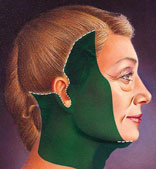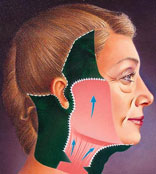

| |
What
Is A Facelift?
A facelift, technically called rhytidectomy,
is a surgical procedure to improve visible signs of aging in the
face and neck.
Sagging in the mid face can create a deep
crease below the lower lid ( called a tear trough ) and between
the nose and mouth ( nasolabial fold ) that may make you appear
tired and sad. Fat that has fallen or is displaced and loss of
muscle tone in the lower face may create jowls ( a jaw line that
sags into the neck ). Loose skin and excess fatty deposits under
the chin and jaw can make even a person of normal weight appear
to have a "double chin".
A facelift is designed to correct all of these aging features,
restoring a more youthful, rested appearance with uplifted contours
and improved ton in facial skin and underlying muscle. Where desired
improvement can be isolated to the mid facial region and where
excess skin is less a factor, a limited incision lift may be an
alternative to a traditional facelift.
As a restorative surgery, a facelift does not change your fundamental
appearance and cannot stop the aging process. Although you will
continue to age naturally, aging will progress from the more youthful
version of yourself that has been restored by a facelift. Rejuvenation
procedures typically performed in conjunction with a facelift are
brow lift, to correct a sagging or deeply furrowed brow, and eyelid
surgery to rejuvenate aging eyes.
Where Do I Begin?
A consultation with Dr.
Novotny is the first step to learn how a facelift
can improve your aging face and neck.
A consultation is designed to fully educate you about a facelift
in a non-pressure environment and will include:
- A discussion of your goals and an evaluation
of your individual case
- The options available to you for
facelift and facial rejuvenation
- The likely outcomes of a
facelift and any risks or potential complications
- The course of treatment recommended by Dr.
Novotny
- Dr. Novotny will also answer any of your questions
|
|
| |
|
| Incisions
usually begin above the hairline at the temples, follow the
natural line in front of the ear, curve behind the earlobe
into the crease behind the ear, and into or along the lower
scalp. |
|
| Facial,
neck tissue and muscle may be separated; fat may be trimmed
or suctioned and underlying muscle may be tightened. |
 |
| After
deep tissues are tightened, the excess skin is pulled up and
back, trimmed and sutured into place. |
 |
| Most
of the scars will be hidden within your hair and in the normal
creases of your skin. |
|






